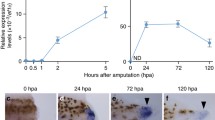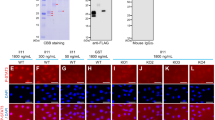Abstract
The morphology and the immuno-distribution of the inducible isoform of nitric oxide synthase (iNOS) have been examined in regenerating tails from differently aged Xenopus laevis larvae. By comparing stage-50 and stage-55/56 tadpoles, various morphological aspects and immunoreactivity to anti-iNOS antibody in terms of the number and duration of positive cells have been demonstrated in the regenerating buds. Unlike in stage-50 larvae, the extent of responses to tail amputation in older larvae is more dependent on the individual tadpole and a high percentage (70%-80%) of malformed tails has been seen. The findings indicate that the decline in the efficiency of Xenopus tail regeneration is driven by differences in the inflammatory responses and in the involvement of nitric oxide. This molecule is induced and required for normal tail regeneration, whereas in excess, it is probably associated with progressive loss in the regeneration capability.




Similar content being viewed by others
References
Bancroft JD, Gamble M (2002) Theory and practice of histological techniques, 5th edn. Churchill Livingstone, Edinburgh
Beck CW, Christen B, Slack JM (2003) Molecular pathways needed for regeneration of spinal cord and muscle in a vertebrate. Dev Cell 5:429–439
Beck CW, Izpisúa Belmonte JC, Christen B (2009) Beyond early development: Xenopus as an emerging model for the study of regenerative mechanisms. Dev Dyn 238:1226–1248
Christen B, Beck CW, Lombardo A, Slack JM (2003) Regeneration-specific expression pattern of three posterior Hox genes. Dev Dyn 226:349–355
Christen B, Robles V, Raya M, Paramonov I, Belmonte JC (2010) Regeneration and reprogramming compared. BMC Biol 8:5
Colasanti M, Mazzone V, Mancinelli L, Leone S, Venturini G (2009) Involvement of nitric oxide in the head regeneration of Hydra vulgaris. Nitric Oxide 21:164–170
Colwell AS, Longaker MT, Lorenz HP (2005) Mammalian fetal organ regeneration. Adv Biochem Eng Biotechnol 93:83–100
Eming SA, Hammerschmidt M, Krieg T, Roers A (2009) Interrelation of immunity and tissue repair or regeneration. Semin Cell Dev Biol 20:517–527
Ferguson MW, O'Kane S (2004) Scar-free healing: from embryonic mechanisms to adult therapeutic intervention. Philos Trans R Soc Lond Biol 359:839–850
Franchini A, Casarini L, Malagoli D, Ottaviani E (2009) Expression of the genes siamois, engrailed-2, bmp4 and myf5 during Xenopus development in presence of the marine toxins okadaic acid and palytoxin. Chemosphere 77:308–812
Fukazawa T, Naora Y, Kunieda T, Kubo T (2009) Suppression of the immune response potentiates tadpole tail regeneration during the refractory period. Development 136:2323–2327
Godwin JW, Brockes JP (2006) Regeneration, tissue injury and the immune response. J Anat 209:423–432
Grow M, Neff AW, Mescher AL, King MW (2006) Global analysis of gene expression in Xenopus hindlimbs during stage-dependent complete and incomplete regeneration. Dev Dyn 235:2667–2685
Gurtner GC, Werner S, Barrandon Y, Longaker MT (2008) Wound repair and regeneration. Nature 453:314–321
Han M, Yang X, Lee J, Allan CH, Muneoka K (2008) Development and regeneration of the neonatal digit tip in mice. Dev Biol 315:125–135
Harty M, Neff AW, King MW, Mescher AL (2003) Regeneration or scarring: an immunologic perspective. Dev Dyn 226:268–279
Hsu SM, Raine L, Fanger H (1981) Use of avidin-biotin-peroxidase complex (ABC) immunoperoxidase techniques: a comparison between ABC and unlabeled antibody (PAP) procedures. J Histochem Cytochem 29:577–580
Ishino T, Shirai M, Kunieda T, Sekimizu K, Natori S, Kubo T (2003) Identification of genes induced in regenerating Xenopus tadpole tails by using the differential display method. Dev Dyn 226:317–325
Ito M, Yang Z, Andl T, Cui C, Kim N, Millar SE, Cotsarelis G (2007) Wnt-dependent de novo hair follicle regeneration in adult mouse skin after wounding. Nature 447:316–320
Kanao T, Miyachi Y (2006) Lymphangiogenesis promotes lens destruction and subsequent lens regeneration in the newt eyeball, and both processes can be accelerated by transplantation of dendritic cells. Dev Biol 290:118–124
Lepiller S, Franche N, Solary E, Chluba J, Laurens V (2009) Comparative analysis of zebrafish nos2a and nos2b genes. Gene 445:58–65
Luo JD, Chen AF (2005) Nitric oxide: a newly discovered function on wound healing. Acta Pharmacol Sin 26:259–264
Mathew LK, Sengupta S, Kawakami A, Andreasen EA, Löhr CV, Loynes CA, Renshaw SA, Peterson RT, Tanguay RL (2007) Unraveling tissue regeneration pathways using chemical genetics. J Biol Chem 282:35202–35210
Mescher AL, Neff AW (2005) Regenerative capacity and the developing immune system. Adv Biochem Eng Biotechnol 93:39–66
Mochii M, Taniguchi Y, Shikata I (2007) Tail regeneration in the Xenopus tadpole. Dev Growth Differ 49:155–161
Munitz A, Levi-Schaffer F (2004) Eosinophils: “new” roles for “old” cells. Allergy 59:268–275
Neufeld DA, Zhao W (1995) Bone regrowth after digit tip amputation in mice is equivalent in adults and neonates. Wound Repair Regen 3:461–466
Nieuwkoop PD, Faber J (1967) Normal table of Xenopus laevis (Daudin), 2nd edn. North-Holland, Amsterdam
Pearl EJ, Barker D, Day RC, Beck CW (2008) Identification of genes associated with regenerative success of Xenopus laevis hindlimbs. BMC Dev Biol 8:66
Redd MJ, Cooper L, Wood W, Stramer B, Martin P (2004) Wound healing and inflammation: embryos reveal the way to perfect repair. Philos Trans R Soc Lond Biol 359:777–784
Rizk M, Witte MB, Barbul A (2004) Nitric oxide and wound healing. World J Surg 28:301–306
Schäffer MR, Tantry U, Gross SS, Wasserburg HL, Barbul A (1996) Nitric oxide regulates wound healing. J Surg Res 63:237–240
Schäffer MR, Tantry U, Thornton FJ, Barbul A (1999) Inhibition of nitric oxide synthesis in wounds: pharmacology and effect on accumulation of collagen in wounds in mice. Eur J Surg 165:262–267
Sicard RE (2002) Differential inflammatory and immunological responses in tissue regeneration and repair. Ann NY Acad Sci 961:368–371
Slack JM, Beck CW, Gargioli C, Christen B (2004) Cellular and molecular mechanisms of regeneration in Xenopus. Philos Trans R Soc Lond Biol 359:745–751
Slack JM, Lin G, Chen Y (2008) The Xenopus tadpole: a new model for regeneration research. Cell Mol Life Sci 65:54–63
Stoick-Cooper CL, Moon RT, Weidinger G (2007) Advances in signaling in vertebrate regeneration as a prelude to regenerative medicine. Genes Dev 21:1292–1315
Sugiura T, Taniguchi Y, Tazaki A, Ueno N, Watanabe K, Mochii M (2004) Differential gene expression between the embryonic tail bud and regenerating larval tail in Xenopus laevis. Dev Growth Differ 46:97–105
Tazaki A, Kitayama A, Terasaka C, Watanabe K, Ueno N, Mochii M (2005) Macroarray-based analysis of tail regeneration in Xenopus laevis larvae. Dev Dyn 233:1394–1404
Tseng AS, Adams DS, Qiu D, Koustubhan P, Levin M (2007) Apoptosis is required during early stages of tail regeneration in Xenopus laevis. Dev Biol 301:62–69
Tseng AS, Levin M (2008) Tail regeneration in Xenopus laevis as a model for understanding tissue repair. J Dent Res 87:806–816
Witte MB, Barbul A (2002) Role of nitric oxide in wound repair. Am J Surg 183:406–412
Acknowledgements
We thank Prof. Pietro Cardellini (Department of Biology, Padova University, Italy) for supplying sexually mature females and male samples of Xenopus laevis.
Author information
Authors and Affiliations
Corresponding author
Additional information
This work was supported by a grant from the University of Modena and Reggio Emilia.
Rights and permissions
About this article
Cite this article
Franchini, A., Bertolotti, E. Tail regenerative capacity and iNOS immunolocalization in Xenopus laevis tadpoles. Cell Tissue Res 344, 261–269 (2011). https://doi.org/10.1007/s00441-011-1136-3
Received:
Accepted:
Published:
Issue Date:
DOI: https://doi.org/10.1007/s00441-011-1136-3




